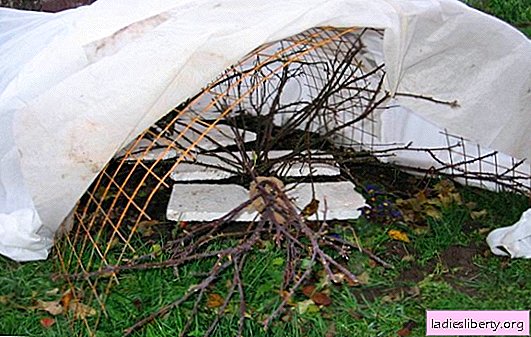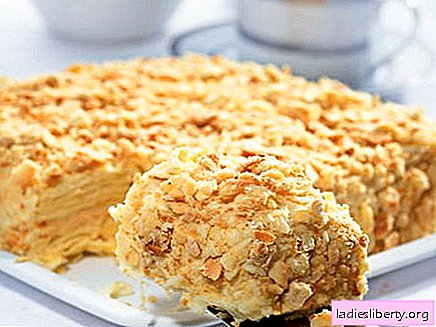
It is pleasant to admire the rose bushes throughout the summer, but with the advent of autumn, buds appear less and less on them, the leaves turn yellow. It's time to prepare for the winter season. However, you can not leave the bushes without proper care during this period. They all also need care. How to care for roses in the fall?
Comprehensive fall care arrangements for roses
Beginners in gardening tend to make many mistakes by first planting a varietal beauty in their area. Many people believe that a rose is a cold-resistant plant, therefore it does not need special preparation for cold weather. But it is not so.
The fact is that nowadays, mainly breeding plants are cultivated, which have lost their natural ability to stop vegetation with the onset of cold weather. Often, rose bushes go under the snow with leaves and buds. But it should not be so!
Streams of cold frosty air stop the vegetation only at negative temperatures, but it is worth the mark on the thermometer to rise above zero, as the sap flow mechanism starts again at the bush. Simply put, roses "wake up" in the middle of winter, and this leads to the threat of freezing. Winters in our latitudes are unstable, temperature drops are not uncommon. After a brief thaw, frost will strike again, then there are pink bushes and the danger lies in wait: the juice in the tissues of the plant freezes, as a result, the shoots crack. Various microorganisms settle in such cracks, which lead to diseases and rotting. That is why the plant needs to be helped to suspend the vegetation process in the fall and build a winter shelter that will reduce temperature fluctuations. How to do it?
1. Properly feed the roses in the fall.
2. Observe watering standards.
3. Trim the stems and shoots.
4. Mulch.
5. Set shelters over the bushes.
In addition, to stop the growth of new shoots, you need to stop loosening the soil around the bushes. It is forbidden to cut flowers with long stems in autumn. Those shoots that continue to grow must be nipped regularly.
Experienced gardeners believe that the autumn blooming of roses greatly weakens the plant, so the buds break. This technique helps to stop the budding process and the growth of new side shoots.
Important! Remember that the buds need not be cut completely, as in the summer, but only break down and leave, as shown in the photo.

Rules for choosing autumn fertilizers for roses
During the preparation of garden roses for winter, they are no longer fed with nitrogen complexes, which stimulate the formation and growth of shoots. As a rule, since August, the plant is transferred to phosphorus-potash fertilizing.
The recipe for the first autumn makeup for roses
• superphosphate - 25 gr;
• boric acid - 2.5 g;
• potassium sulfate - 10 g;
• water - 10 liters.
The resulting solution is enough to conduct a complete top dressing of rose bushes on an area of 4 square meters. meter.
In early September, carry out a second recharge with the following solution:
• superphosphate - 15 g;
• potassium monophosphate - 15 g;
• water - 10 liters.
The resulting solution can be used to water the rosary or foliar top dressing, but for the last procedure, the concentration must be reduced by three times.
The application of special granular fertilizers for autumn use also gives good results.
How to water the rose garden in the fall?
With the advent of September, you need to monitor the regime of watering plants. It should be moderate, as necessary. If the weather is too wet, then the bushes should be protected from excess moisture. For this, a frame is pulled over them and covered with a film.
Excess moisture near the roots provokes the growth of new shoots, which do not have time to mature properly before the cold and freeze. In addition, roses will develop a superficial root system that is easily damaged in winter. All this will greatly weaken the bush, in the spring instead of young shoots there will be dry pods.
It is possible to completely stop watering only if it rains abundantly, there is enough natural moisture for the life of the bush. If the weather is dry, then the rose garden continues to be watered once a week. However, the water rate must be reduced by 3-5 liters. Roses must not be allowed to go under the snow without sufficient moisture, otherwise they will dry out. Seeing dry plants in spring, inexperienced gardeners believe that they froze, but this is not so. Roses simply dried out under a hard layer of soil.
We grow roses correctly
One of the important procedures for caring for roses in the fall is to mulch the root of the neck. It must be carried out on time and correctly.
1. You need to start mulching when stable frosts are established. Short-term first frosts are not terrible for the plant, but prolonged low temperatures are fatal. Even at -3 degrees, the rose may freeze.
2. Near the ground itself, the plant must be mulched with dry ground.
3. Low-growing roses mulch to a height of 10 cm, and tall - up to 40 cm.
4. In regions with frequent temperature changes, mulching can be done with sand. It dries faster and protects the plant from aging.
5. Before hilling, you need to remove all leaves from the bushes in order to prevent their decay and the spread of infections.
Attention! Experienced summer residents advise to cultivate the bushes with copper preparations before hilling to protect the rose garden from infections.
How to prune roses in the fall
Before installing shelter on roses, they should be trimmed. To prepare for winter, you need all the roses, not just young plants. The procedure should be carried out according to certain rules.
• Remove all leaves, broken and weak shoots, buds and flowers.
• Next, carefully inspect the bush, leaving up to five of the most developed shoots, the rest are cut under the root.
• The remaining shoots are shortened.
Pruning roses is carried out depending on their type. Repairing roses are pruned at the level of 5-7 buds, the so-called middle pruning. For polyanthus, tea-hybrid roses and floorbund do a short pruning of 3 buds. Tall varieties of roses only slightly shorten.

Shelter for roses for the winter
They begin to shelter roses in late October or early November. In different regions, the timing may vary slightly. At the same time, park roses do not need additional frame shelter, it is enough to sprinkle them with earth and dry foliage.
More tender and moody hybrid tea, as well as other varieties of shelter is more reliable. To begin with, the bushes are spudded, and then covered with fir spruce branches, on top of which a frame of waterproof material is installed: a film, roofing material, lutrasil. Such a shelter will not get wet even during the thaw period.
Some gardeners practice a wire mesh frame into which dry leaves or mulch are poured. A nonwoven fabric is pulled over the frame.

Today in stores you can find ready-made covers for roses made of spunbond. They are used similarly to the previous method.
Climbing roses snthey are wiped off the supports, laid on a layer of dry foliage and pinned to the ground. Then they need to be covered with a layer of dry foliage and spruce branches. If you can’t remove the plant, then it is wrapped on a trellis. To begin with, shoots are tied with spruce branches, and then covered with burlap.











